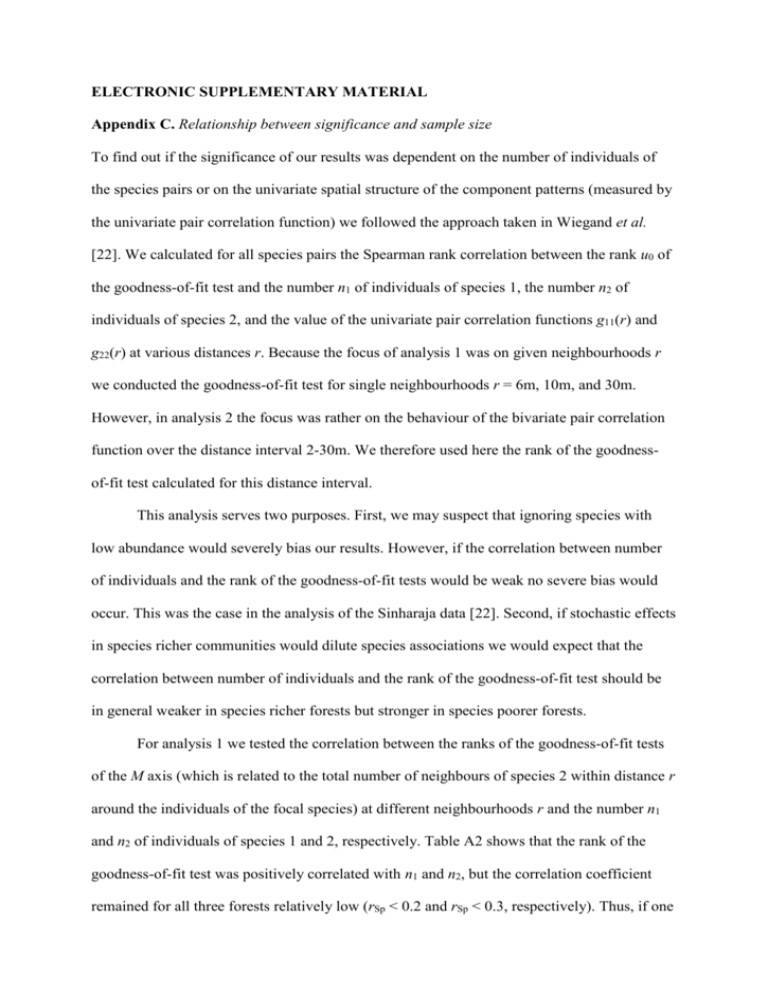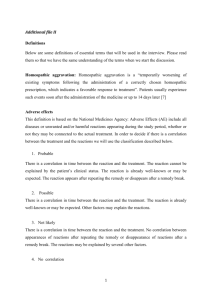Appendix C
advertisement

ELECTRONIC SUPPLEMENTARY MATERIAL Appendix C. Relationship between significance and sample size To find out if the significance of our results was dependent on the number of individuals of the species pairs or on the univariate spatial structure of the component patterns (measured by the univariate pair correlation function) we followed the approach taken in Wiegand et al. [22]. We calculated for all species pairs the Spearman rank correlation between the rank u0 of the goodness-of-fit test and the number n1 of individuals of species 1, the number n2 of individuals of species 2, and the value of the univariate pair correlation functions g11(r) and g22(r) at various distances r. Because the focus of analysis 1 was on given neighbourhoods r we conducted the goodness-of-fit test for single neighbourhoods r = 6m, 10m, and 30m. However, in analysis 2 the focus was rather on the behaviour of the bivariate pair correlation function over the distance interval 2-30m. We therefore used here the rank of the goodnessof-fit test calculated for this distance interval. This analysis serves two purposes. First, we may suspect that ignoring species with low abundance would severely bias our results. However, if the correlation between number of individuals and the rank of the goodness-of-fit tests would be weak no severe bias would occur. This was the case in the analysis of the Sinharaja data [22]. Second, if stochastic effects in species richer communities would dilute species associations we would expect that the correlation between number of individuals and the rank of the goodness-of-fit test should be in general weaker in species richer forests but stronger in species poorer forests. For analysis 1 we tested the correlation between the ranks of the goodness-of-fit tests of the M axis (which is related to the total number of neighbours of species 2 within distance r around the individuals of the focal species) at different neighbourhoods r and the number n1 and n2 of individuals of species 1 and 2, respectively. Table A2 shows that the rank of the goodness-of-fit test was positively correlated with n1 and n2, but the correlation coefficient remained for all three forests relatively low (rSp < 0.2 and rSp < 0.3, respectively). Thus, if one of the species of a pair was more abundant, the association of this species pair was somewhat more likely to be significant. For analysis 2, the rank u0 of the goodness-of-fit test (conducted for the bivariate pair correlation function over the distance interval 0-30m with respect to the heterogeneous Poisson process) correlated weakly and positively with the number of individuals of species 2 (BCI: rSp = 0.13; p < 0.01; Sinharaja: rSp = 0.15; CBS: 0.34, p < 0.01), and with the number of individuals of species 1 (BCI: rSp = 0.06, p < 0.01; Sinharaja: rSp = 0.03; CBS: 0.4, p < 0.01). Thus, the significant interspecific associations detected did not primarily depend on the sample sizes although as expected, significant effects tended to be more frequent for larger sample sizes and the correlation was stronger for the species poorer CBS forest. The latter is compatible with the dilution hypothesis. We also found negative correlations of the rank of u0 of the goodness-of-fit test (conducted for the bivariate pair correlation function over the distance interval 0-30m with respect to the heterogeneous Poisson process) with the univariate pair correlation function of focal species 1 and species 2 (figure A5a). The correlations were weak for BCI and Sinharaja but strong for CBS, and there was little dependence on scale (figure A5a). This result indicated that it was less likely to find significant small-scale associations with more aggregated species, and the correlation was strong for the species poorer CBS forest. The latter is compatible with the dilution hypothesis. We found similar results for the pair correlation function of the second species (figure A5b), but here the weak correlation were positive for BCI and Sinharaja. The quantitative agreement of the correlation coefficients found for BCI with those obtained in the study of the Sinharaja forest is surprising.




